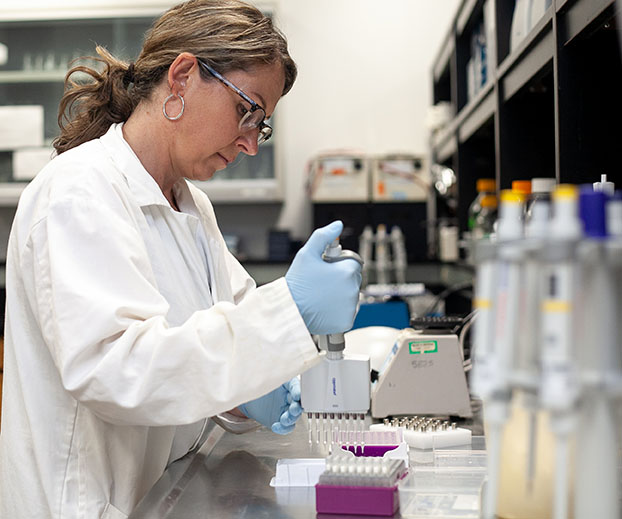
Uncovering the secrets of the earth to mitigate climate change
In a teaspoon of soil, there are more microorganisms than humans on Earth. One teaspoon has billions of microbes, and tens of thousands of different kinds.
By Ashleigh MatternThat complexity is a challenge for soil microbiologists like Dr. Bobbi Helgason (PhD), associate professor in the Department of Soil Science at the University of Saskatchewan (USask).
She works in agricultural systems looking at microorganisms in the soil and microorganisms associated with plants to better understand how they support nutrient cycling and plant growth.
One area of particular focus for Helgason is soil carbon.
“Soil carbon is a really hot topic because of its importance for mitigation of climate change,” she said. “We know that soils store a lot of carbon—they’re important sinks for carbon dioxide removal from the atmosphere—and soil microorganisms are important agents of the amount and form of carbon stored in the soil.
“It’s a positive thing our agriculture systems do for society, and more broadly, it’s an important mechanism of combating climate change. Soil carbon, the backbone of soil organic matter, is also at the heart of soil fertility. It is critical for healthy agroecosystems.”
She’s working to understand how to optimize and promote the processes that stabilize carbon in the soil.
With soil carbon sequestration, plants capture carbon dioxide in the air and build it into their tissues. Later in the plant’s life cycle, that carbon gets sequestered in the soil through the process of microbial decomposition, Helgason said.
“Soil carbon change boils down to inputs minus outputs equals change in storage,” she said. “We can either increase plant growth or other types of carbon we might apply to the land, or we can decrease their decomposition.”
Microbes have some similarities to us humans. When we ingest carbohydrates and metabolize the energy in that food, it creates carbon dioxide, some of which we breathe back out. Microbes are doing the same thing, Helgason said.
“They’re taking plant tissues and consuming them. When they consume them, they build some of that plant carbon into their own cells … When they die, those carbon-containing molecules can become stabilized in the soil. If microbes grow inefficiently, most get respired back into the atmosphere.”
Farmers can promote more efficient microbes by managing the soils differently. That might mean reduced tillage, or changing the crop rotation because, Helgason said, “microbes like a balanced diet.”
“Some microorganisms are more efficient than others,” she said. “So we can use the way we manage our agricultural systems to try to enhance the activity of the efficient ones and keep more carbon in the soil.”
Opening the black box
Carbon is everywhere but it can be difficult to follow below ground because we can’t see it, Helgason said. The earth is a black box.
But advances in science are changing that.
The university has built capacity to use a stable isotope tracer—a form of carbon with an extra neutron—making it easier to detect with specialized equipment.
Helgason and her research team have been labelling plants with that tracer and then following the decomposition of the molecules. The plants are put in a special growth chamber where the atmosphere is filled with this tracer.
“The plants go along and do their usual photosynthesis and incorporate that tracer into their molecules just like any other carbon atom,” Helgason said.
Tracking the carbon in this way allows the researchers to create experiments where they can manipulate the conditions to find ways to keep more carbon in the soil.
“Unpacking something so complex is difficult, but with these tracers we get a clearer picture of which [microbes] are important for promoting carbon stabilization.”
Looking at roots in particular offers some helpful clues, Helgason said. Living plants feed the microbes around them; the carbon exuded from the roots feeds the microorganisms, which in turn returns resources back to the plant in a synergistic relationship.
“We can look at how much root carbon gets deposited by crops of different species. … Because of the size and the nature of different rooting systems, they not only put more or less carbon below ground but it gets there in different forms.”

The positive benefits of agriculture
Helgason has always had a fascination with farms. She was born and raised in Saskatchewan on a grain farm near St. Gregor, Sask., about 135 kilometres east of Saskatoon.
“Every time I drive in rural Saskatchewan in the summer, I find it remarkable how much food we produce here,” she said.
“Understanding how we can do that in the most positive way, both for the success of farmers themselves and society in general, makes this an exciting place to build a career. And because microbes have so much to contribute to sustainable agriculture, there are many avenues of fascinating research to explore.”
Throughout her career, she’s worked on soil biological processes. She did her bachelor’s and master’s degrees at the College of Agriculture and Bioresources, then moved to Lethbridge, Alta., to take a job with Agriculture and Agri-Food Canada. She came back to USask to complete her PhD.
Using molecular biology and researching DNA for these types of applications was just emerging when she was an undergrad student, a shift from traditional culture-based microbiology.
“The number of tools available to us to understand these complex processes has exploded,” she said. “We’re always building better capacity to dig deeper and understand more.”
It’s cutting-edge work that she said keeps her on her toes.
“It’s a continually changing challenge, but it’s exciting. We are talking about a complex ecosystem, so all of this increased precision allows us to dig deeper and understand more.”
She also appreciates the collaborative nature of the work; her area of study connects her with a wide range of other scientists and professionals.
“The microbial piece is just one part of the equation,” she said.
Her work includes understanding how to implement the research on farms, making it an important part of maintaining and enhancing long-term productivity of soil systems, as well as preserving and enhancing the health of our agricultural ecosystems and all of the adjacent ecosystems that they impact.
“Carbon storage is one of those very positive benefits that agriculture plays for society. By storing more carbon in the soil, our goal is to enhance climate change mitigation and build healthier soils,” she said.
Agknowledge, Fall 2021

